#laravel advanced tutorials
Explore tagged Tumblr posts
Text
Top 10 Laravel Development Companies in the USA in 2024
Laravel is a widely-used open-source PHP web framework designed for creating web applications using the model-view-controller (MVC) architectural pattern. It offers developers a structured and expressive syntax, as well as a variety of built-in features and tools to enhance the efficiency and enjoyment of the development process.

Key components of Laravel include:
1. Eloquent ORM (Object-Relational Mapping): Laravel simplifies database interactions by enabling developers to work with database records as objects through a powerful ORM.
2. Routing: Laravel provides a straightforward and expressive method for defining application routes, simplifying the handling of incoming HTTP requests.
3. Middleware: This feature allows for the filtering of HTTP requests entering the application, making it useful for tasks like authentication, logging, and CSRF protection.
4. Artisan CLI (Command Line Interface): Laravel comes with Artisan, a robust command-line tool that offers commands for tasks such as database migrations, seeding, and generating boilerplate code.
5. Database Migrations and Seeding: Laravel's migration system enables version control of the database schema and easy sharing of changes across the team. Seeding allows for populating the database with test data.
6. Queue Management: Laravel's queue system permits deferred or background processing of tasks, which can enhance application performance and responsiveness.
7. Task Scheduling: Laravel provides a convenient way to define scheduled tasks within the application.
What are the reasons to opt for Laravel Web Development?
Laravel makes web development easier, developers more productive, and web applications more secure and scalable, making it one of the most important frameworks in web development.
There are multiple compelling reasons to choose Laravel for web development:
1. Clean and Organized Code: Laravel provides a sleek and expressive syntax, making writing and maintaining code simple. Its well-structured architecture follows the MVC pattern, enhancing code readability and maintainability.
2. Extensive Feature Set: Laravel comes with a wide range of built-in features and tools, including authentication, routing, caching, and session management.
3. Rapid Development: With built-in templates, ORM (Object-Relational Mapping), and powerful CLI (Command Line Interface) tools, Laravel empowers developers to build web applications quickly and efficiently.
4. Robust Security Measures: Laravel incorporates various security features such as encryption, CSRF (Cross-Site Request Forgery) protection, authentication, and authorization mechanisms.
5. Thriving Community and Ecosystem: Laravel boasts a large and active community of developers who provide extensive documentation, tutorials, and forums for support.
6. Database Management: Laravel's migration system allows developers to manage database schemas effortlessly, enabling version control and easy sharing of database changes across teams. Seeders facilitate the seeding of databases with test data, streamlining the testing and development process.
7. Comprehensive Testing Support: Laravel offers robust testing support, including integration with PHPUnit for writing unit and feature tests. It ensures that applications are thoroughly tested and reliable, reducing the risk of bugs and issues in production.
8. Scalability and Performance: Laravel provides scalability options such as database sharding, queue management, and caching mechanisms. These features enable applications to handle increased traffic and scale effectively.
Top 10 Laravel Development Companies in the USA in 2024
The Laravel framework is widely utilised by top Laravel development companies. It stands out among other web application development frameworks due to its advanced features and development tools that expedite web development. Therefore, this article aims to provide a list of the top 10 Laravel Development Companies in 2024, assisting you in selecting a suitable Laravel development company in the USA for your project.
IBR Infotech

IBR Infotech excels in providing high-quality Laravel web development services through its team of skilled Laravel developers. Enhance your online visibility with their committed Laravel development team, which is prepared to turn your ideas into reality accurately and effectively. Count on their top-notch services to receive the best as they customise solutions to your business requirements. Being a well-known Laravel Web Development Company IBR infotech is offering the We provide bespoke Laravel solutions to our worldwide customer base in the United States, United Kingdom, Europe, and Australia, ensuring prompt delivery and competitive pricing.
Additional Information-
GoodFirms : 5.0
Avg. hourly rate: $25 — $49 / hr
No. Employee: 10–49
Founded Year : 2014
Verve Systems
Elevate your enterprise with Verve Systems' Laravel development expertise. They craft scalable, user-centric web applications using the powerful Laravel framework. Their solutions enhance consumer experience through intuitive interfaces and ensure security and performance for your business.
Additional Information-
GoodFirms : 5.0
Avg. hourly rate: $25
No. Employee: 50–249
Founded Year : 2009
KrishaWeb

KrishaWeb is a world-class Laravel Development company that offers tailor-made web solutions to our clients. Whether you are stuck up with a website concept or want an AI-integrated application or a fully-fledged enterprise Laravel application, they can help you.
Additional Information-
GoodFirms : 5.0
Avg. hourly rate: $50 - $99/hr
No. Employee: 50 - 249
Founded Year : 2008
Bacancy
Bacancy is a top-rated Laravel Development Company in India, USA, Canada, and Australia. They follow Agile SDLC methodology to build enterprise-grade solutions using the Laravel framework. They use Ajax-enabled widgets, model view controller patterns, and built-in tools to create robust, reliable, and scalable web solutions
Additional Information-
GoodFirms : 4.8
Avg. hourly rate: $25 - $49/hr
No. Employee: 250 - 999
Founded Year : 2011
Elsner
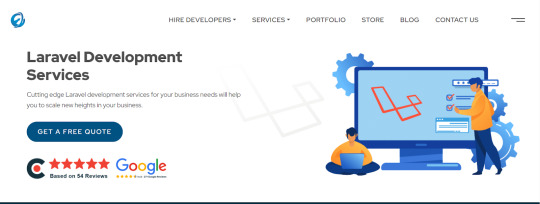
Elsner Technologies is a Laravel development company that has gained a high level of expertise in Laravel, one of the most popular PHP-based frameworks available in the market today. With the help of their Laravel Web Development services, you can expect both professional and highly imaginative web and mobile applications.
Additional Information-
GoodFirms : 5
Avg. hourly rate: < $25/hr
No. Employee: 250 - 999
Founded Year : 2006
Logicspice

Logicspice stands as an expert and professional Laravel web development service provider, catering to enterprises of diverse scales and industries. Leveraging the prowess of Laravel, an open-source PHP framework renowned for its ability to expedite the creation of secure, scalable, and feature-rich web applications.
Additional Information-
GoodFirms : 5
Avg. hourly rate: < $25/hr
No. Employee: 50 - 249
Founded Year : 2006
Sapphire Software Solutions
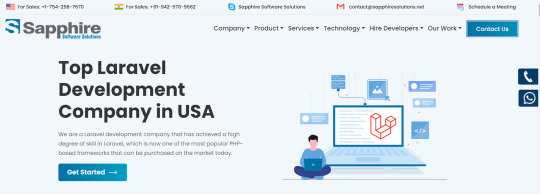
Sapphire Software Solutions, a leading Laravel development company in the USA, specialises in customised Laravel development, enterprise solutions,.With a reputation for excellence, they deliver top-notch services tailored to meet your unique business needs.
Additional Information-
GoodFirms : 5
Avg. hourly rate: NA
No. Employee: 50 - 249
Founded Year : 2002
iGex Solutions
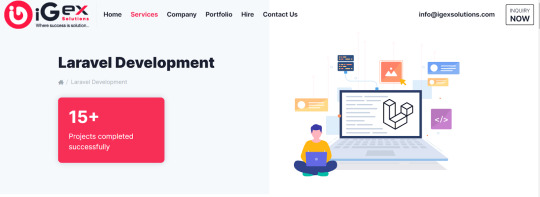
iGex Solutions offers the World’s Best Laravel Development Services with 14+ years of Industry Experience. They have 10+ Laravel Developer Experts. 100+ Elite Happy Clients from there Services. 100% Client Satisfaction Services with Affordable Laravel Development Cost.
Additional Information-
GoodFirms : 4.7
Avg. hourly rate: < $25/hr
No. Employee: 10 - 49
Founded Year : 2009
Hidden Brains
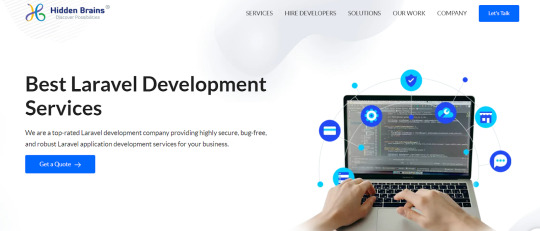
Hidden Brains is a leading Laravel web development company, building high-performance Laravel applications using the advantage of Laravel's framework features. As a reputed Laravel application development company, they believe your web application should accomplish the goals and can stay ahead of the rest.
Additional Information-
GoodFirms : 4.9
Avg. hourly rate: < $25/hr
No. Employee: 250 - 999
Founded Year : 2003
Matellio
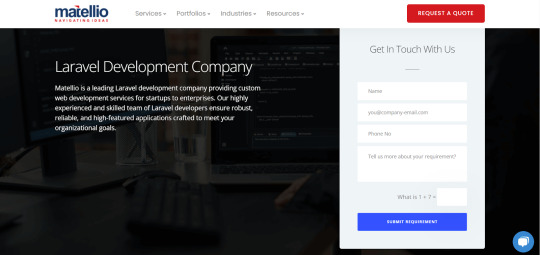
At Matellio, They offer a wide range of custom Laravel web development services to meet the unique needs of their global clientele. There expert Laravel developers have extensive experience creating robust, reliable, and feature-rich applications
Additional Information-
GoodFirms : 4.8
Avg. hourly rate: $50 - $99/hr
No. Employee: 50 - 249
Founded Year : 2014
What advantages does Laravel offer for your web application development?
Laravel, a popular PHP framework, offers several advantages for web application development:
Elegant Syntax
Modular Packaging
MVC Architecture Support
Database Migration System
Blade Templating Engine
Authentication and Authorization
Artisan Console
Testing Support
Community and Documentation
Conclusion:
I hope you found the information provided in the article to be enlightening and that it offered valuable insights into the top Laravel development companies.
These reputable Laravel development companies have a proven track record of creating customised solutions for various sectors, meeting client requirements with precision.
Over time, these highlighted Laravel developers for hire have completed numerous projects with success and are well-equipped to help advance your business.
Before finalising your choice of a Laravel web development partner, it is essential to request a detailed cost estimate and carefully examine their portfolio of past work.
#Laravel Development Companies#Laravel Development Companies in USA#Laravel Development Company#Laravel Web Development Companies#Laravel Web Development Services
2 notes
·
View notes
Text
How to Make Money with Programming: 9 Proven Ways to Earn from Your Coding Skills – Infographic
Programming isn’t just a skill, it’s a passport to countless income opportunities. Whether you’re a beginner or a seasoned developer, there are many ways to turn your coding knowledge into a reliable stream of income.
In this blog post infographic, we’ll explore nine effective ways to make money with programming, from starting a blog to developing games and selling online courses.

Download Infographic
1. Blogging
If you enjoy writing and have a passion for coding, blogging can be a fantastic way to earn money. Starting a programming blog allows you to share tutorials, code snippets, solutions to technical problems, or industry news. Over time, as your blog gains traffic, you can monetise it through:
Google AdSense
Affiliate Marketing (promote tools like GitHub Copilot, hosting providers, or IDEs)
Sponsored Posts
Email List Marketing
Choose a specific niche like Python automation, web development, or data science to attract a targeted audience. The more value you provide, the more loyal readers and passive income you can build.
2. Sell Books
Programmers who can write clearly and teach effectively often find success in self-publishing. Writing an eBook or paperback on a specific programming language, framework, or topic can generate steady income. You could publish:
Beginner guides (e.g. “Learn Python in 30 Days”)
Advanced problem-solving books
Interview preparation guides
You can sell books on platforms like Amazon Kindle Direct Publishing, Gumroad, or your own website. Add bonus material like source code or video content to increase value.
3. Web/App Development
One of the most straightforward and lucrative ways to make money with programming is by developing websites or mobile apps. Businesses everywhere need online presence and custom solutions. You can:
Build websites using WordPress, React, or Laravel
Develop mobile apps using Flutter or React Native
Offer eCommerce development (e.g. Shopify or WooCommerce)
You can sell your services to local businesses, startup founders, or online clients. Alternatively, create your own app or SaaS (Software as a service) and monetise it through subscriptions or ads.
4. YouTube Tutorials
YouTube is a powerful platform for programmers looking to build an audience and generate income. If you’re good at explaining concepts, start a programming channel with:
Coding tutorials (e.g. “Build a Todo App in JavaScript”)
Explainer videos (e.g. “What is an API?”)
Career advice and learning paths
You can earn money through YouTube ad revenue, channel memberships, sponsored videos, and affiliate links. Once your audience grows, you can also use your channel to promote your own products, like courses or software.
5. Freelancing
Freelancing offers flexibility and the ability to earn while working on a wide variety of projects. Platforms like:
Upwork
Freelancer
Fiverr
Toptal
…connect you with clients looking for developers. Whether it’s bug fixes, full-stack development, automation scripts, or WordPress setup, there’s always demand. To succeed, create a strong portfolio, offer competitive pricing, and deliver great results to gain repeat clients and referrals.
6. Games Development
If you’re passionate about gaming and have strong programming skills, consider game development. Platforms like Unity (C#) or Unreal Engine (C++) make it accessible to solo developers. You can:
Create indie games and publish them on Steam or itch.io
Build mobile games and monetise via ads or in-app purchases
Sell game assets, templates, or source code
Some developers also earn by creating tutorials, documentation, or toolkits that help other game developers.
7. Competitions
Coding competitions and hackathons are not just fun, they can be profitable too. Websites like:
HackerRank
Codeforces
TopCoder
Kaggle (for data science)
…often have prize money or sponsorship opportunities. Many companies also host hackathons and innovation challenges where winners receive cash, job offers, or equity. Even if you don’t win, competitions sharpen your skills and can improve your resume or portfolio.
8. Sell Software
Have a great idea for a tool that solves a problem? Package it as software and sell it! This could include:
SaaS tools (e.g. CRM for freelancers)
Developer tools (e.g. code snippet managers)
Desktop apps (e.g. productivity tools)
Browser extensions
You can monetise through one-time purchases, monthly subscriptions, or freemium models with paid upgrades. Promote your product through your blog, social media, or YouTube channel to build traction.
9. Sell Courses
Online learning is booming, and if you’re an expert in a topic, you can create and sell your own programming course. Platforms like:
Udemy
Teachable
Gumroad
Skillshare
…allow you to host and sell your courses to a global audience. Courses could focus on specific programming languages, frameworks, or skills like API development, data analysis, or building real-world apps.
High-quality video content, practical projects, and community support (e.g. Discord or Facebook group) will help you stand out and keep your students engaged.
Conclusion
Programming is one of the most versatile and valuable skills you can have in today’s economy. Whether you would like to work for yourself or build a side hustle, there are many ways to make money with coding, from sharing your knowledge through blogs or courses to building products and solutions for clients or the marketplace.
The key is to start with one path, stay consistent, and keep learning. As you grow in experience and confidence, you can diversify your income by combining multiple strategies. For example, many successful developers run blogs, YouTube channels, and sell software or courses all at once.
So pick your starting point, and begin turning your coding skills into real-world income!
0 notes
Text
Laravel Development Company in New York
LDS Engineers is a main Laravel Development Company in New York, supplying extraordinary PHP website development services offerings worldwide. With a team of professional developers, we assist companies create powerful, scalable, and feature-rich internet programs using Laravel. Our goal is to deliver fast, secure, and user-pleasant websites that enhance your online presence and business increase.
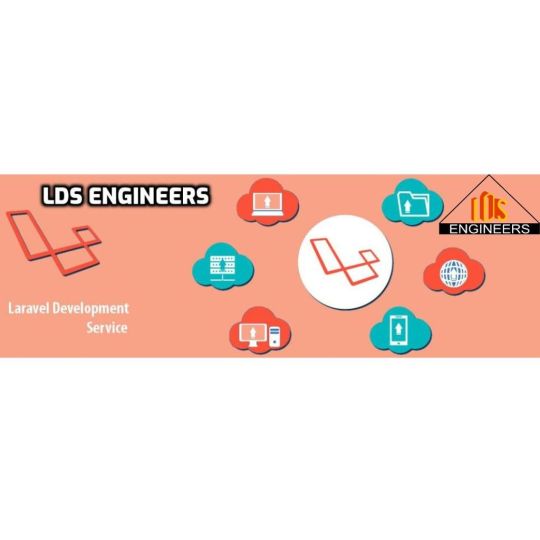
Why Choose LDS Engineers for Laravel Development?
At LDS Engineers, we specialize in Laravel development, ensuring our customers get nice answers to or their wishes. We have a group of experienced Laravel builders who manage each element of the development manner with efficiency. Whether it’s an easy internet site or a complex internet application, we use validated strategies to develop top-notch digital solutions.
We offer Laravel Development services to clients throughout Australia, the United Kingdom, India, and the USA. Our knowledge of Laravel ensures that we create robust and excessive-acting packages tailored to your unique requirements.
Our Laravel Development Process:
We comply with a customer-centric approach, ensuring seamless conversation and collaboration with our clients at each step. Our Laravel development manner consists of:
Project Analysis – We start with the aid of knowing your enterprise goals and studying the venture necessities.
Design
Design& Prototyping – Our designers create a user-friendly and visually appealing interface for your website or application.
Development – Our Laravel developers bring your vision to life, using clean and optimized code.
Testing & Quality Assurance – We conduct unit testing and quality checks to ensure a bug-free and smooth experience.
Deployment & Support – After launching the project, we provide continuous support and maintenance for seamless performance.
We believe in transparency, and that’s why we involve our clients in every phase of the project. This ensures that the final product aligns perfectly with their expectations.
Our Expertise in Laravel Development We have constructed numerous fast, scalable, and characteristic-wealthy web packages with the usage of Laravel. Whether you want a custom website, an ecommerce platform, or a business portal, we have the understanding to supply stable and high-overall performance answers.
Our Laravel Development services include:
Custom Laravel Web Development – Tailored solutions to fulfill your unique enterprise needs.
Laravel ecommerce Development – Scalable and function-wealthy online stores for seamless buying reports.
Laravel API Development – Secure and green API integrations in your programs.
Laravel Maintenance & Support – Ongoing support to ensure your website remains up-to-date and runs smoothly.
Why Laravel? Laravel is one of the most famous PHP frameworks, regarded for its smooth and elegant syntax, sturdy safety, and top-notch performance.
It permits builders to construct scalable, bendy, and excessive-performing internet programs with advanced capabilities.
Some key blessings of Laravel include:
Faster Development process High safety and built-in authentication Seamless database migration Easy integration with third-birthday celebration equipment Get Started with LDS Engineers PHP Laravel Developer Today!
If you're searching for a depended-on Laravel Development company, LDS Engineers is right here to help. With our know-how and commitment to excellence, we make certain your internet programs are effective, scalable, and future-prepared.
Contact us today and let’s build something amazing together!
Laravel Website Template, Laravel tutorial, Laravel development solutions, Laravel web development services, Laravel web development, Laravel services, PHP Laravel developer.
#LaravelDevelopment#LaravelWebDevelopment#PHPDeveloper#LaravelTutorial#LaravelServices#LaravelTemplate#LaravelSolutions#LaravelCompany#LDSengineers#NewYorkDevelopment#tumblr#aesthetic#like#instagram#follow#photography#instagood#art#quotes#likeforlikes#tumblraesthetic#explore#citazioni#explorepage#likes#tumblrpost#photooftheday
0 notes
Text
Build Portfolio Website in Laravel 11: Your Comprehensive Guide
Building a portfolio website is an essential step for showcasing your skills, projects, and achievements in today's competitive world. Laravel 11, the latest version of the robust PHP framework, offers unparalleled tools and features to create a stunning and functional portfolio website. In this guide, we’ll walk you through the process of building a portfolio website in Laravel 11, ensuring you have a step-by-step roadmap to success.
Why Choose Laravel 11 for Your Portfolio Website?
1. Modern Features
Laravel 11 introduces enhanced routing, improved performance, and advanced tooling that make it the go-to choice for web development.
2. Scalability
Whether you're a freelancer or a business owner, Laravel 11's scalability ensures your website can grow as your portfolio expands.
3. Security
With built-in authentication and security features, Laravel 11 protects your data and provides peace of mind.
4. Community Support
Laravel’s vast community ensures you’ll find solutions to problems, tutorials, and plugins to enhance your website.
Key Features of a Portfolio Website
To build a portfolio website in Laravel 11, ensure it includes:
Homepage: A welcoming introduction.
About Section: Your background and expertise.
Projects: A gallery showcasing your work.
Contact Form: Easy communication.
Blog Section: Share insights and updates.
Responsive Design: Optimized for all devices.
Getting Started with Laravel 11
Step 1: Install Laravel 11
Start by setting up Laravel 11 on your local environment.
composer create-project --prefer-dist laravel/laravel portfolio-website
Step 2: Configure Your Environment
Update your .env file to set up the database and other environment variables.
DB_CONNECTION=mysql
DB_HOST=127.0.0.1
DB_PORT=3306
DB_DATABASE=portfolio
DB_USERNAME=root
DB_PASSWORD=yourpassword
Step 3: Set Up Authentication
Laravel 11 offers seamless authentication features.
php artisan make:auth
This command generates routes, controllers, and views for user authentication.
Step 4: Design Your Database
Create tables for your portfolio items, such as projects, blogs, and user profiles. Use migrations to structure your database.
php artisan make:migration create_projects_table
In the migration file:
Schema::create('projects', function (Blueprint $table) {
$table->id();
$table->string('title');
$table->text('description');
$table->string('image')->nullable();
$table->timestamps();
});
Run the migration:
php artisan migrate
Building the Frontend
Step 1: Choose a CSS Framework
Laravel integrates well with frameworks like Tailwind CSS and Bootstrap. Install Tailwind CSS for modern and responsive designs:
npm install -D tailwindcss
npx tailwindcss init
Configure your Tailwind file and integrate it into your project.
Step 2: Create Blade Templates
Laravel’s Blade templating engine simplifies building dynamic pages. Create a layout file in resources/views/layouts/app.blade.php:
<!DOCTYPE html>
<html>
<head>
<title>@yield('title')</title>
<link rel="stylesheet" href="{{ asset('css/app.css') }}">
</head>
<body>
<div class="container">
@yield('content')
</div>
</body>
</html>
Use this layout in other views:
@extends('layouts.app')
@section('title', 'Home')
@section('content')
<h1>Welcome to My Portfolio</h1>
@endsection
Step 3: Dynamic Content
Fetch portfolio items from the database and display them dynamically using controllers.
public function index() {
$projects = Project::all();
return view('home', compact('projects'));
}
In your Blade template:
@foreach ($projects as $project)
<div class="project">
<h2>{{ $project->title }}</h2>
<p>{{ $project->description }}</p>
<img src="{{ $project->image }}" alt="{{ $project->title }}">
</div>
@endforeach
Advanced Features
1. Search Functionality
Add search to help visitors find specific projects or blogs.
public function search(Request $request) {
$query = $request->input('query');
$projects = Project::where('title', 'LIKE', "%{$query}%")->get();
return view('search-results', compact('projects'));
}
2. File Uploads
Enable uploading images for projects.
public function store(Request $request) {
$request->validate([
'title' => 'required',
'description' => 'required',
'image' => 'nullable|image',
]);
$imagePath = $request->file('image')->store('projects', 'public');
Project::create([
'title' => $request->title,
'description' => $request->description,
'image' => $imagePath,
]);
}
3. Integrate Analytics
Use Google Analytics or similar tools to track visitor behavior.
4. Deploying Your Website
Deploy your Laravel website using platforms like Laravel Forge, AWS, or Heroku. Ensure to optimize the performance with caching and minification.
Optimizing Your Portfolio Website for SEO
Keyword Integration: Use keywords like “Build Portfolio Website in Laravel 11” strategically in titles, meta descriptions, and content.
Fast Loading Times: Optimize images and use caching.
Responsive Design: Ensure compatibility with mobile devices.
Content Strategy: Regularly update your blog to attract organic traffic.
Conclusion
Building a portfolio website in Laravel 11 is an enriching experience that showcases your skills and work to the world. By leveraging the framework’s capabilities and integrating advanced features, you can create a website that stands out in the digital landscape. Start your journey today and make your mark with a professional portfolio website
0 notes
Text
Why Use Laravel to Develop Faster Web-Based Apps?
In the fast-evolving world of web development, choosing the right framework is crucial for building efficient, scalable, and high-performance applications. Laravel, a PHP framework, has emerged as a popular choice among developers for creating robust web-based apps quickly. Here’s why Laravel stands out and why you should consider it for your next web development project.

Elegant Syntax and Readability
Laravel is known for its elegant syntax that is easy to understand and write. This readability reduces the learning curve for new developers and enhances productivity for experienced ones. The clean and expressive syntax facilitates easier code maintenance and debugging, which is crucial for developing complex applications swiftly.
MVC Architecture
Laravel follows the Model-View-Controller (MVC) architectural pattern, which separates the business logic, presentation, and data layers. This separation simplifies the development process, making it easier to manage and scale applications. The MVC architecture also enhances performance and ensures that your web apps are both robust and maintainable.
Comprehensive Documentation
One of Laravel’s strong points is its comprehensive and well-structured documentation. Whether you’re a beginner or an advanced developer, Laravel’s documentation provides detailed guides, examples, and API references. This extensive documentation helps in speeding up the development process by providing clear instructions and solutions to common problems.
Built-in Authentication and Authorization
Laravel offers built-in tools for implementing authentication and authorization, saving developers significant time. The framework provides a simple and secure way to manage user authentication, including login, registration, password resets, and email verification. These out-of-the-box features help in quickly setting up secure user access in web applications.
Eloquent ORM
Laravel’s Eloquent ORM (Object-Relational Mapping) makes interacting with databases straightforward and intuitive. Eloquent provides a beautiful and easy-to-use ActiveRecord implementation for working with your database. This allows developers to perform database operations using simple, expressive syntax, reducing the time and effort needed to manage database interactions.
Artisan Command-Line Interface
Laravel comes with Artisan, a powerful command-line interface that provides a range of helpful commands for common tasks during development. From database migrations and seedings to creating boilerplate code, Artisan streamlines the development workflow, enabling developers to focus on building features rather than repetitive tasks.
Blade Templating Engine
Laravel’s Blade templating engine is simple yet powerful, allowing developers to create dynamic and reusable templates with ease. Blade’s lightweight syntax and template inheritance features help in building complex layouts quickly and efficiently. This templating engine enhances productivity by reducing the amount of boilerplate code and promoting code reuse.
Robust Ecosystem and Community Support
Laravel boasts a robust ecosystem with numerous packages and tools that extend its functionality. From Laravel Echo for real-time events to Laravel Passport for API authentication, the ecosystem offers solutions for various development needs. Additionally, Laravel has a vibrant community of developers who contribute to its continuous improvement, provide support, and share knowledge through forums, tutorials, and conferences.
Testing and Debugging Tools
Laravel places a strong emphasis on testing, with built-in support for PHPUnit and various testing methods. This focus on testing ensures that applications are reliable and bug-free. Laravel also offers debugging tools like Laravel Telescope, which provides insights into the application's requests, exceptions, and database queries, making it easier to identify and fix issues promptly.
Scalability and Performance Optimization
Laravel is designed with scalability in mind. Whether you’re building a small web app or a large enterprise solution, Laravel’s modular architecture and performance optimization features ensure that your application can handle increased traffic and complex operations efficiently. Laravel's caching, session management, and queueing system contribute to faster load times and improved application performance.
Conclusion
Laravel is a powerful and versatile framework that accelerates the development of web-based applications. Its elegant syntax, robust features, and supportive community make it an excellent choice for developers looking to build high-performance and scalable applications quickly. By leveraging Laravel’s capabilities, you can streamline your development process, reduce time-to-market, and deliver exceptional web-based apps that meet modern standards.
By using Laravel, you not only enhance your productivity but also ensure that your applications are secure, maintainable, and future-proof. So, if you’re planning to develop a web-based app, consider Laravel for a faster, efficient, and enjoyable development experience.
#web development#perception system#web portal development#software development#cloud consulting#web design#ecommerce development#it services#mobile app development#perception systemarketing
0 notes
Text
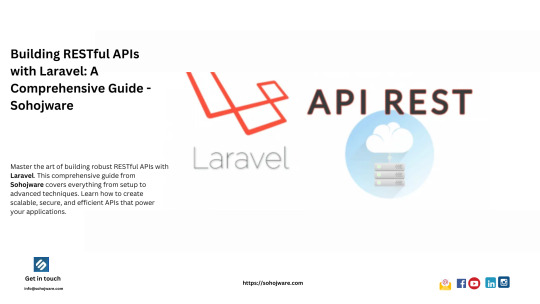
The digital landscape thrives on seamless communication and data exchange. This is where APIs (Application Programming Interfaces) come into play, acting as the bridge between different applications. For developers seeking a powerful and efficient framework to build APIs, LaravelAPIs, Laravel shines brightly.
This comprehensive guide, brought to you by Sohojware, a leading US-based software development company, dives deep into the world of building RESTful APIs with Laravel. We'll explore the core aspects, equipping you with the knowledge to craft powerful APIs that fuel your applications.
What are RESTful APIs with Laravel?
APIs with Laravel, specifically RESTful APIs, adhere to the principles of Representational State Transfer (REST) architecture. REST dictates a set of guidelines for designing APIs that promote scalability, interoperability, and ease of use. Laravel, a popular PHP framework, offers exceptional support for building these RESTful APIs. Its built-in features and structured approach streamline development, making it a favorite among developers.
Why Build APIs with Laravel?
There are numerous reasons why Laravel stands out for crafting APIs. Here are just a few:
Rapid Development: Laravel's elegant syntax and pre-built functionalities accelerate the development process. You can focus on core functionalities rather than reinventing the wheel.
Robust Security: Laravel prioritizes security with features like built-in authentication, authorization, and CSRF protection. This ensures your APIs are well-guarded against vulnerabilities.
Scalability: APIs with Laravel are built to scale. The framework can handle increasing traffic and data demands efficiently, future-proofing your applications.
Elegant Documentation: Laravel encourages the creation of well-documented APIs. This makes it easier for other developers to understand and integrate with your creation.
Large Community: Laravel boasts a vast and active community. This provides you with ample resources, tutorials, and support when needed.
Building Blocks of a RESTful API with Laravel
Now, let's delve into the core components involved in building APIs with Laravel:
Setting Up Your Laravel Project:
Defining Data Models and Migrations:
Building Controllers:
Defining API Routes:
Handling Authentication and Authorization:
Testing Your API:
Beyond the Basics: Advanced Considerations for APIs with Laravel
While the above steps form the foundation, building production-grade APIs with Laravel involves additional considerations:
Error Handling: Implement comprehensive error handling mechanisms to provide informative messages in case of issues.
Data Validation: Enforce data validation rules to ensure data integrity and prevent unexpected behavior in your API.
Versioning: As your API evolves, implement versioning to manage changes and maintain compatibility with existing integrations.
Rate Limiting: Prevent abuse by implementing rate-limiting mechanisms to control the number of requests an API can receive.
FAQs about Building APIs with Laravel
Is Sohojware experienced in building APIs with Laravel?
Absolutely! Sohojware's expert developers have extensive experience crafting powerful and scalable APIs using Laravel. We can help you design, develop, and deploy APIs that align perfectly with your needs.
What are the benefits of using Sohojware for building my API?
Sohojware offers a comprehensive approach to API development. We not only focus on technical excellence but also prioritize security, scalability, and ongoing maintenance. We work closely with you to understand your requirements and deliver a high-performing API that fuels your application's success.
Does Sohojware provide post-development support for APIs with Laravel?
Sohojware understands that API maintenance is critical. We offer ongoing support plans to ensure your API remains secure, and up-to-date, and continues to meet your evolving needs.
How can I get started with building APIs with Laravel?
If you're new to Laravel or API development, don't worry! Sohojware can be your trusted partner in this journey. We offer comprehensive API development services, including:
API Consultation: Our experts can assess your project requirements and provide tailored recommendations.
API Design and Development: We'll craft a well-structured and efficient API that meets your specific needs.
API Testing and Optimization: Rigorous testing ensures your API performs optimally and delivers accurate results.
API Deployment and Maintenance: We handle the deployment process and provide ongoing support to keep your API running smoothly.
Sohojware's commitment to excellence ensures that your API project is in capable hands.
Conclusion
Building APIs with Laravel empowers you to create powerful and scalable applications. By understanding the fundamentals of RESTful architecture and leveraging Laravel's powerful features, you can develop APIs that drive innovation.
Sohojware, as a leading API development company in the US, is dedicated to helping you harness the full potential of Laravel for your API projects. Contact us today to discuss your API needs and let us guide you towards success.
Remember: A well-crafted API is the cornerstone of modern applications. Choose Laravel and Sohojware for a winning combination.
1 note
·
View note
Text
Understanding Your Options: PHP vs. Python in Web Development
In the expansive realm of web development, the choice of programming language plays a pivotal role in determining the success and efficiency of your projects. Among the array of options available, PHP and Python emerge as prominent contenders, each bringing its own strengths and tailored applications. Whether you're a seasoned developer or new to the field, understanding the distinctions between PHP and Python is essential for making well-informed decisions that align with your project objectives and team dynamics.

The Debate: PHP vs. Python
The debate over PHP versus Python has captivated developers for years, driven not just by personal preferences but by practical considerations such as:
Project Requirements
The specific needs and scope of your project heavily influence whether PHP or Python is the optimal choice. PHP excels in web development, adept at creating dynamic websites and applications that integrate seamlessly with databases. Python, renowned for its versatility, extends beyond web development to encompass fields like scientific computing, data analysis, and artificial intelligence, offering a broader spectrum of applications.
Ease of Use
Both PHP and Python are celebrated for their user-friendly nature, albeit catering to different strengths. PHP's syntax is finely tuned for web development tasks, making it intuitive for developers familiar with web technologies. In contrast, Python's clear and readable syntax enhances code maintenance and fosters collaboration, making it especially appealing to beginners and teams prioritizing code clarity.
Community and Support
The robustness of a programming language's community profoundly influences its evolution and support ecosystem. PHP boasts a dedicated community focused on web development, ensuring comprehensive resources, tutorials, and documentation tailored to specific needs. Python, with its expansive and diverse community, serves a broad spectrum of professionals across various domains, driving continual growth and adaptation within the tech industry.
Performance and Scalability
Performance considerations are crucial, particularly for handling high-traffic web applications. PHP has significantly enhanced its performance with advancements like PHP 7, complemented by frameworks like Laravel and Symfony designed for scalability and efficiency. Python, although not traditionally noted for raw speed, compensates with frameworks such as Django and Flask, optimizing performance through efficient coding practices and robust third-party libraries.
PHP: Powering Web Development
PHP, originally an acronym for Hypertext Preprocessor, has been a stalwart in web development since its inception. Key reasons PHP remains a preferred choice include:
Specialization: Tailored specifically for web development, PHP excels in generating dynamic content and integrating seamlessly with databases. Frameworks like Laravel and Symfony provide developers with powerful tools and libraries for rapid application development.
Community and Resources: PHP benefits from a large, engaged community that contributes extensively to documentation and support resources. This wealth of knowledge ensures swift resolution of challenges, reinforcing PHP's reliability for building and maintaining web applications.
Scalability and Performance: PHP's evolution, particularly with PHP 7, has bolstered its scalability and performance capabilities. Its compatibility with leading web servers such as Apache and Nginx further enhances deployment flexibility and operational efficiency.

Python: Versatility and Beyond
Python's ascent in popularity is fueled by its adaptability and widespread applicability across diverse domains. Key reasons developers favor Python extend beyond traditional web development:
Readability and Simplicity: Python's clean syntax enhances readability and simplifies code maintenance, fostering collaboration and minimizing errors. This characteristic makes Python an excellent choice for projects prioritizing clarity and ease of comprehension.
Rich Ecosystem: Python boasts a vast ecosystem of libraries and frameworks catering to varied needs—from Django and Flask for web development to specialized tools like NumPy and Pandas for scientific computing and data analysis. The language's support extends to advanced fields such as machine learning with libraries like TensorFlow and PyTorch.
Community and Innovation: Python's expansive community drives continuous innovation and adaptation, ensuring the language remains at the forefront of technological advancements. This collaborative spirit underscores Python's relevance across industries and its resilience in evolving tech landscapes.
Choosing the Right Path
When deciding between PHP and Python for your web development projects, consider these critical factors:
Project Requirements: Assess whether your project necessitates specialized web development capabilities (PHP) or requires the flexibility to expand into diverse domains (Python).
Team Expertise: Evaluate your team's familiarity with each language and their proficiency in leveraging associated frameworks and libraries effectively.
Future Growth: Stay attuned to emerging trends and evolving web technologies to anticipate future project needs. Ensure your chosen language aligns with long-term goals and supports scalability as your project evolves.
Conclusion
In conclusion, PHP excels in specialized web development tasks with its robust frameworks and dedicated community. Meanwhile, Python offers versatility and scalability across a broad spectrum of applications, making it an ideal choice for projects requiring flexibility and future-proofing. By carefully weighing these considerations against your project's requirements and team capabilities, you can confidently navigate the dynamic landscape of web development, whether harnessing PHP's established strengths or exploring Python's expansive possibilities.
For those eager to deepen their Python expertise, consider exploring advanced courses or specialized training opportunities such as a Python course in Hyderabad, offering invaluable insights and practical skills to master this versatile language.
0 notes
Text
Core PHP vs Laravel – Which to Choose?
Choosing between Core PHP and Laravel for developing web applications is a critical decision that developers and project managers face. This blog aims to explore the unique aspects of each, current trends in 2024, and how new technologies influence the choice between the two. We'll dive into the differences between core php and Laravel ecosystems, performance, ease of use, community support, and how they align with the latest technological advancements.
Introduction to Core PHP and Laravel
Core PHP refers to PHP in its raw form, without any additional libraries or frameworks. It gives developers full control over the code they write, making it a powerful option for creating web applications from scratch. On the other hand, Laravel is a PHP framework that provides a structured way of developing applications. It comes with a set of tools and libraries designed to simplify common tasks, such as routing, sessions, caching, and authentication, thereby speeding up the development process for any business looking to hire php developers.
Unique Aspects of Core PHP and Laravel
Core PHP:
Flexibility and Control: Offers complete freedom to write custom functions and logic tailored to specific project requirements.
Performance: Without the overhead of a framework, Core PHP can perform faster in scenarios where the codebase is optimized and well-written.
Learning Curve: Learning Core PHP is essential for understanding the fundamentals of web development, making it a valuable skill for developers.
Laravel:
Ecosystem and Tools: Laravel boasts an extensive ecosystem, including Laravel Vapor for serverless deployment, Laravel Nova for administration panels, and Laravel Echo for real-time events.
MVC Architecture: Promotes the use of Model-View-Controller architecture, which helps in organizing code better and makes it more maintainable.
Blade Templating Engine: Laravel’s Blade templating engine simplifies tasks like data formatting and layout management without slowing down application performance.
Trends in 2024
Headless and Microservices Architectures: There's a growing trend towards using headless CMSes and microservices architectures. Laravel is particularly well-suited for this trend due to its ability to act as a backend service communicating through APIs.
Serverless Computing: The rise of serverless computing has made frameworks like Laravel more attractive due to their compatibility with cloud functions and scalability.
AI and Machine Learning Integration: Both Core PHP and Laravel are seeing libraries and tools that facilitate the integration of AI and machine learning functionalities into web applications.
New Technologies Influencing PHP Development
Containerization: Docker and Kubernetes are becoming standard in deployment workflows. Laravel Sail provides a simple command-line interface for managing Docker containers, making Laravel applications easier to deploy and scale.
WebSockets for Real-Time Apps: Technologies like Laravel Echo allow developers to easily implement real-time features in their applications, such as live chats and notifications.
API-First Development: The need for mobile and single-page applications has pushed the adoption of API-first development. Laravel excels with its Lumen micro-framework for creating lightning-fast APIs.
Performance and Scalability
Performance and scalability are crucial factors in choosing between Core PHP and Laravel. While Core PHP may offer raw performance benefits, Laravel's ecosystem contains tools and practices, such as caching and queue management, that help in achieving high scalability and performance for larger applications.
Community Support and Resources
Laravel enjoys robust community support, with a wealth of tutorials, forums, and third-party packages available. Core PHP, being the foundation, also has a vast amount of documentation and community forums. The choice might depend on the type of support and resources a developer is comfortable working with.
PHP 8,3 vs Laravel 10
Comparing the latest versions of PHP (8.3) and Laravel (10) reveals distinct advancements tailored to their respective ecosystems. PHP 8.3 brings enhancements such as Typed Class Constants, dynamic class constant and Enum member fetch support, along with the introduction of new functions like json_validate() and mb_str_pad(), aimed at improving the language's robustness and developer experience. The addition of the #[\Override] attribute further emphasizes PHP's commitment to cleaner code and better inheritance management. On the other side, Laravel 10 updates its arsenal with support for its latest version across various official packages including Breeze, Cashier Stripe, Dusk, Horizon, and others, ensuring a seamless integration and enhanced developer toolkit. These updates focus on enriching Laravel's ecosystem, providing more out-of-the-box features, and improving the development process for web applications. While PHP 8.3 focuses on language level improvements and new functionalities for a broader range of PHP applications, Laravel 10 hones in on refining the framework's capabilities and ecosystem, making web development more efficient and scalable.
Conclusion
The decision between Core PHP and Laravel comes down to the project's specific requirements, the top PHP development companies and their team's expertise, and the desired scalability and performance characteristics. For projects that require rapid development with a structured approach, Laravel stands out with its comprehensive ecosystem and tools. Core PHP remains unbeatable for projects requiring custom solutions with minimal overhead.
In 2024, the trends towards serverless computing, microservices, and API-first development are shaping the PHP development services landscape. Laravel's alignment with these trends makes it a compelling choice for modern web applications. However, understanding Core PHP remains fundamental for any PHP developer, offering unparalleled flexibility and control over web development projects.
Embracing new technologies and staying abreast of trends is crucial, whether choosing Core PHP for its directness and speed or Laravel for its rich features and scalability. The ultimate goal is to deliver efficient, maintainable, and scalable web applications that meet the evolving needs of users and businesses alike.
0 notes
Text
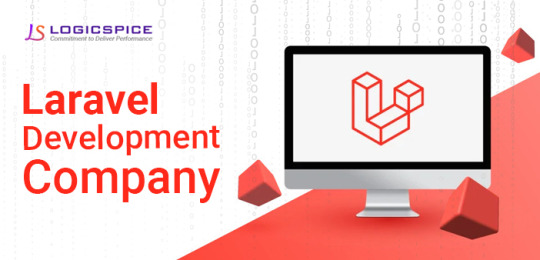
Unleashing the Power of Laravel: A Comprehensive Guide for Web Development Companies
In the ever-evolving landscape of web development, Laravel has emerged as a game-changing PHP framework, empowering developers and companies alike to create robust, scalable, and feature-rich web applications with unparalleled efficiency. This comprehensive guide delves into the key aspects of Laravel that make it a standout choice for web development companies seeking to streamline their processes and deliver exceptional results.
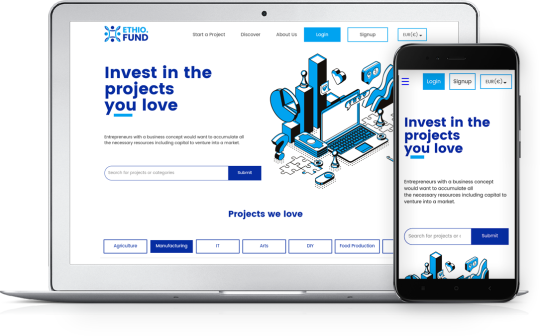
1. The Elegance of Laravel's Syntax: Laravel's syntax is renowned for its elegance and expressiveness, setting it apart from traditional PHP programming. With its clean and readable code structure, developers can write maintainable and collaborative codebases, reducing the time and effort required for onboarding new team members or revisiting legacy code.
2. Eloquent ORM: Simplifying Database Interactions: Laravel's Eloquent ORM (Object-Relational Mapping) is a powerful tool that simplifies database interactions, allowing developers to work with complex data structures effortlessly. With its advanced features like relationships, mutators, and accessors, Eloquent streamlines database operations, saving precious development time and resources.
3. Robust Security: A Top Priority: Web application security is a critical concern for any development company, and Laravel excels in this area. Its built-in features for handling user authentication, password resets, and role-based access control ensure that applications are secure from the ground up. Additionally, Laravel's robust security features can be easily customized and extended to meet specific project requirements, providing peace of mind for both developers and clients.
4. Intuitive Routing and URL Structure: Laravel's intuitive routing system allows developers to define clean and user-friendly URLs for their applications. From handling CRUD operations with resource routing to creating custom routes and middleware, Laravel's routing capabilities are both powerful and flexible, enabling Laravel web development services companies to deliver seamless user experiences.
5. Ecosystem of Packages and Tools: One of Laravel's greatest strengths lies in its vast ecosystem of packages and tools contributed by its vibrant community. Whether a project requires social media integration, subscription billing, or advanced features like real-time notifications, Laravel's package ecosystem offers a wealth of solutions, accelerating development timelines and reducing the need for reinventing the wheel.
6. Emphasis on Testing and Quality Assurance: Laravel's strong emphasis on testing is a game-changer for web development companies seeking to deliver high-quality, reliable applications. With built-in support for unit testing, feature testing, and browser testing with Laravel Dusk, developers can write robust and maintainable code with confidence, ensuring a seamless user experience and facilitating future upgrades and refactoring.
7. Vibrant and Supportive Community: Laravel's community is one of its greatest assets, providing a vast network of developers, extensive documentation, tutorials, and forums. This supportive ecosystem ensures that web development companies have access to valuable resources and best practices, enabling them to tackle any challenge and stay at the forefront of web development innovation.
8. Scalability and Performance: As web applications grow in complexity and user base, scalability and performance become critical considerations. Laravel's architecture and features, such as caching, queuing, and load balancing, empower web development companies to build applications that can handle high traffic and scale seamlessly, ensuring a smooth user experience even under heavy loads.
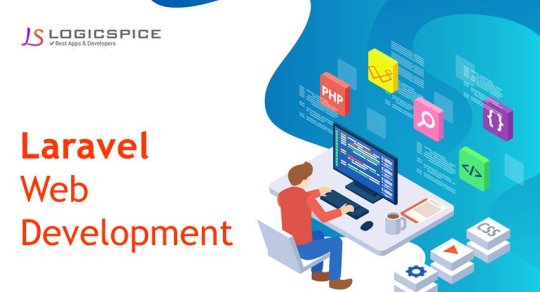
By leveraging the power of Laravel, laravel development companies can streamline their processes, enhance collaboration, ensure robust security, deliver exceptional user experiences, and stay ahead of the curve in the ever-changing web development landscape. With its elegant syntax, powerful ORM, robust security features, intuitive routing, extensive package ecosystem, emphasis on testing, vibrant community, and scalability, Laravel is the ultimate framework for companies seeking to unlock their full potential in web development. If you're seeking a reliable and skilled partner to bring your Laravel-powered web applications to life, look no further than LogicSpice. As a leading Laravel development company, they have a proven track record of delivering exceptional results, leveraging the full potential of this powerful framework to craft scalable, secure, and high-performing solutions tailored to your business needs.
#laravel web development company#laravel development company#laravel development services#laravel app development company#laravel app development services#laravel agency#laravel company
0 notes
Text
Mastering the Code: A Step-by-Step Guide on How to Become a Self-Taught Full Stack Developer
Certainly! I’m excited to delve into the world of full-stack development with you. My expertise in this field has grown significantly over time. Selenium has emerged as a widely acknowledged and extensively utilized practice spanning various industries. Advance your career in Full-Stack Developer at a Top Institution in Chennai, like ACTE Technologies.

Embarking on the journey to become a self-taught full-stack developer requires a structured and disciplined approach.
Here’s A Step-By-Step Guide To Help You Navigate This Path:
1. Set Clear Goals:
Define your objectives and identify specific technologies you want to learn. Break down your goals into manageable milestones.
2. Learn the Basics:
Start with fundamental web development technologies: HTML, CSS, and JavaScript. Understand how browsers render web pages and the basics of client-server communication.
3. Front-End Development:
Dive deeper into front-end technologies. Learn a front-end framework like React, Angular, or Vue.js to build dynamic user interfaces.
4. Version Control:
Familiarize yourself with version control systems, especially Git. Use platforms like GitHub for collaboration.
5. Back-End Development:
Choose a back-end language (e.g., JavaScript/Node.js, Python, Ruby, Java, PHP). Learn a corresponding back-end framework (e.g., Express.js, Django, Ruby on Rails, Spring Boot, Laravel).
6. Databases:
Gain proficiency in both relational (e.g., PostgreSQL, MySQL) and NoSQL databases (e.g., MongoDB). Understand database design and optimization.
7. APIs (RESTful and GraphQL):
Learn how to design, build, and consume APIs. Explore both RESTful and GraphQL APIs.
8. Server Deployment and Cloud Services:
Learn how to deploy applications to servers. Familiarize yourself with cloud services like AWS, Azure, or Google Cloud Platform.
9. Web Application Architecture:
Understand common web application architectures. Learn about client-server models, MVC/MVVM patterns, and microservices.
10. Testing and Debugging: - Master testing techniques and use debugging tools to ensure code reliability.
11. Continuous Learning: - Stay updated with the latest technologies and frameworks. - Engage with online communities, blogs, and tutorials.
12. Build a Portfolio: - Create a portfolio showcasing your projects. Include both front-end and back-end work.
13. Networking: - Attend meetups, conferences, and join online communities to connect with other developers.
14. Freelancing and Open Source: - Consider contributing to open-source projects. - Take on freelance projects to gain practical experience.
15. Soft Skills: - Develop communication, teamwork, and problem-solving skills. - Practice effective time management.
16. Job Search: - Utilize job search platforms and apply to entry-level positions or internships. - Tailor your resume and cover letter to highlight your self-taught journey and projects.
17. Continuous Improvement: - Seek feedback on your work. - Keep refining and expanding your skill set based on industry demands.

Remember, the path to becoming a self-taught full-stack developer is a gradual process, and consistent practice, real-world projects, and continuous learning are key to success.
If you’re keen on exploring a Full-stack Developer course in Chennai, I highly recommend considering Top Institutions like ACTE Technologies. They provide certification programs and job placement opportunities, guided by experienced instructors to enhance your learning journey. These resources are available both online and in person. Enrolling in a course step by step could prove to be a valuable decision if it aligns with your interests.
I trust this addresses your query adequately. If you have more questions or need further clarification, please feel free to ask in the comments section.
If you’ve found this information valuable, I invite you to follow me on this platform and give it an upvote to encourage more discussions and insights about Full-stack Development. Your time and engagement are greatly appreciated, and I wish you a wonderful day ahead.
0 notes
Text
Master Laravel 9: A Comprehensive Tutorial for Beginners by Site Makers
Dive into the world of web development with our beginner-friendly Laravel 9 tutorial on Site Makers. Learn step-by-step how to build powerful web applications using the latest features of Laravel 9. From basic concepts to advanced techniques, this tutorial equips you with the skills to create robust and efficient web solutions.
0 notes
Text
Laravel 10 Add Custom Search Filter To YajraBox Datatable
YajraBox Datatables is a well-known tool for developing dynamic and feature-rich data tables. In this tutorial, you will learn how to apply a custom filter search to YajraBox Datatables in Laravel 10, allowing you to provide advanced filtering features to your users.
By the end of this tutorial, you’ll have the skills and knowledge to improve your Laravel 10 apps by adding custom filter search capabilities to YajraBox Datatables, allowing your users to filter data in a powerful and user-friendly manner.
#laravel tutorials#laravel tutorial#laravel framework#laravel#laravel development services#laravel developers#php development
0 notes
Text
Laravel Certification
https://www.edchart.com/certificate/laravel-certification-free-test
Elegant Syntax: Laravel's expressive and clean syntax simplifies coding, making it a developer-friendly framework. It enhances productivity by reducing code verbosity.
Robust Ecosystem: Laravel offers a rich ecosystem of tools and packages, such as Eloquent ORM, Blade templating engine, and Laravel Mix for asset management, streamlining development tasks.
MVC Architecture: Following the Model-View-Controller (MVC) pattern, Laravel promotes code organization, maintainability, and separation of concerns.
Security Features: Laravel incorporates built-in security mechanisms, including cross-site scripting (XSS) protection, SQL injection prevention, and a robust authentication system.
Community and Documentation: It boasts an active and vast community of developers, ensuring access to extensive documentation, tutorials, and support.
Artisan CLI: Laravel's command-line tool, Artisan, automates routine tasks, simplifying development workflows.
Database Migrations and Seeding: Laravel's database migration and seeding tools simplify database management and version control.
Testing Support: Laravel provides support for unit testing and test-driven development, improving code quality and reliability.
Integration with Frontend Technologies: Laravel integrates seamlessly with modern frontend frameworks like Vue.js, allowing for efficient development of interactive single-page applications.
LTS Versions: Laravel offers long-term support (LTS) versions, ensuring stability and security for extended periods.
A Laravel certification can significantly enhance your career for these reasons:
Validation of Expertise: Certification demonstrates your in-depth knowledge and proficiency in Laravel development, instilling confidence in employers or clients.
Competitive Edge: In a competitive job market, certification sets you apart from other candidates, increasing your employability and earning potential.
Career Advancement: Certified professionals often qualify for higher-paying positions and leadership roles within organizations.
Expanded Opportunities: Many companies actively seek Laravel-certified developers for web projects, broadening your job prospects.

0 notes
Text
TOP 10 ADVANTAGES OF USING LARAVEL FRAMEWORK

Laravel is one of the most popular frameworks that offer custom software development. This framework has got the highest stars on Github, which mentions that more than 56000 developers are currently using it across the globe for responsive web development. Based on Github’s report, it’s quite evident that you have ample choices if you want to hire Laravel developer for your online presence.
However, before choosing any framework, it’s essential that you know its pros and cons well. Otherwise, you won’t be able to make the best out of your project. Therefore, we are sharing the top ten advantages of using the Laravel framework for custom software development. Based on these advantages, you can create a plan that aligns with your business goals and your industry niche by discussing it with your Laravel development company
Before we explain the advantages of the Laravel framework to you, here is a snippet of the Laravel framework and its possibilities
What is Laravel and What are its Uses?
Laravel is a free and open-source PHP framework based on MVC architecture that offers effortless web and app development. Taylor Otwell founded this framework, which got released in June 2011. The latest version of the framework is 8.16.1. Laravel is suitable for developing complex and large websites.
Though Laravel is a bit complex as compared to the other PHP frameworks, it is the most suitable one when it comes to developing extremely powerful web applications. Laravel provides expressive tutorials (Laracasts), documentations and boasts a huge community to assist the developers worldwide.
Some of the vital features of the Laravel framework are Bundles, Query Builder, Reverse Routing, Eloquent ORM, Application Logic, IoC, Migrations, Class Auto Loading, Blade Templating Engine, Automatic Pagination and more. The ORM and routing allow one to develop modern applications with sheer perfection.
The Top 10 Advantages of Using Laravel Framework:
1. Fixing Security Vulnerabilities: Be it any web application, the development phase causes some sort of technical glitch that can be a real threat to security vulnerabilities. Some of the most vulnerable elements are cross-site scripting, SQL injection and site request forgery. Laravel can help you secure your web app with its fanatically guarded codebase.
2. Mail Service Integration: Today, it’s essential for businesses to send service emails to the customers after every event, be it registration or purchase. Laravel makes it better for the SwiftMailer library with its simple, clean API to perform the task. Moreover, Laravel can provide drivers for Mailgun, SMTP, SparkPost and a lot more platforms.
3. Authorization Process: For every app, authorization of the users is a common aspect, which makes the owners sure that the users are authentic people. It helps them to secure their purchase options from unauthorised buyers. Laravel’s authentication process is quite advanced and yet simple, which anyone can implement and use with ease.
4. Faster Application: Recent studies show that users prefer fast-loadable and high-responsive apps on every platform. A slow app can be the reason for the loss of revenue for any business and hence, Laravel can provide the best solution. It comes with in-memory caches such as APC and Memcached and also ensures multiple cache configurations.
5. Built with Testing: For any Laravel development company, the process of testing apps is like a cakewalk. Laravel comes with in-built testing features with PHPUnit and hence it offers speedy and error-free testing every time. There are convenient helper methods in this framework that allow expressive testing of complex large apps.
6. Configuration Error: User experience is partially dependent upon the way an app can handle errors. In many apps, users click the Submit button and then errors are identified. It helps the users to understand which steps are taken wrong and should be corrected. For Laravel, error and exception handling are two of its best features.
7. Queue Service: When an app gets more traffic, it has to handle an excessive number of message requests per second. Now, if the app is developed with an ordinary framework, there are chances of data loss or higher expense. With the unified API system of Laravel, there is no reason to worry. The process of sending messages and emails speeds up in this framework.
8. URL Routing Configuration: The users usually use URL links to see something specific such as the service page or a contact form. If the web app doesn’t have URL routing, it won’t be able to show that exact page and instead will show an error. Laravel uses app/Http/routes.php files to identify URL routes and respond quickly to users’ requests.
9. Separation of Codes: If you hire Laravel developer for your business, you will get to know about this advantage in detail. Laravel is an MVC framework, which can separate business logic code from presentation code. As a result, Html Layout Designers do not need to interact with developers while changing the UI/UX of a web page.
10. Task Scheduling: Every web app requires a task scheduling system to track and manage all its ongoing tasks. Earlier, developers had to generate Cron entries to schedule tasks each time but today, Laravel allows the developers to command schedule tasks within the framework and generate a single Cron entry in the server.
If you are planning for a full-stack Laravel app development, therefore, looking for a Laravel development company to partner with, look no further than us. We, Idiosys Technologies, are one of the most eminent web and app development companies providing a plethora of services including Laravel app development. Headquartered in Kolkata, we basically provide web development, app development and marketing solutions to a huge number of multi-national and start-up companies from India, Canada, the USA, Germany, Australia, Brazil, the UK and Panama. Our expertise and long experience in the industry has made us one of the top web development and IT companies in India. You can hire the most efficient Laravel developers’ team and Laravel framework experts from our company to boost your online presence. So, why wait anymore? Contact us today to know the best deals we can offer you.
0 notes
Text
How to Set Up Laravel 8 on Your Android Phone
Introduction
In today's fast-paced world, mobile devices have become an essential part of our lives, enabling us to stay connected and productive on the go. With the advancement of technology, it's now possible to set up a robust development environment on your Android phone, allowing you to work on projects even when you're away from your desktop. One such platform that empowers developers is Laravel 8, a popular PHP framework for web application development. In this tutorial, we will guide you through the process of setting up Laravel 8 on your Android phone using the Wama technology stack.
Why Laravel 8?
Laravel is renowned for its elegant syntax, powerful features, and comprehensive documentation. Laravel 8, the latest version at the time of writing, brings several improvements and new features that make it even more appealing for developers. Some of these enhancements include Laravel Jetstream for user authentication and scaffolding, enhanced job batching, dynamic Blade components, and improvements to the Artisan command-line interface.
Introducing Wama Technology
Wama technology is an innovative approach that enables you to create a development environment on your Android device. It combines Web Server for Android (WSA), a web server application for Android, with MySQL and PHP, to offer a complete stack for web development. With Wama technology, you can run web applications directly on your Android phone, allowing you to work on projects without the need for a traditional desktop setup.
Follow these steps to set up Laravel 8 on your Android phone using Wama technology:
Step 1: Install Wama Technology Stack
Open the Google Play Store on your Android phone.
Once installed, open the app and follow the instructions to start the server.
Step 2: Download Composer
Open the browser on your Android phone and navigate to https://getcomposer.org/download/.
Download the latest version of Composer.
Step 3: Install Laravel 8
Open the terminal in your Android device (you can use an app like Termux).
Navigate to the root directory of your web server (usually a folder named "htdocs" in the WSA directory).
Use the following command to install Laravel 8:
lua
Copy code
composer create-project --prefer-dist laravel/laravel myproject
Replace "myproject" with your preferred project name.
Step 4: Accessing Laravel 8 on Your Android Phone
Open the browser on your Android phone.
Enter the URL for your Laravel project. It will typically be something like http://localhost:8080/myproject/public/.
You should see the Laravel welcome page, indicating that your setup was successful.
Step 5: Configure the Database
Open the Web Server for Android app and click on the "MySQL" tab.
Open the .env file in your Laravel project and update the database configuration with the values you noted down.
Step 6: Start Developing
Congratulations! You now have Laravel 8 set up on your Android phone. You can start developing your web applications by editing the files in the "myproject" directory.
Tips for Efficient Development
While developing on your Android phone can be convenient, here are some tips to ensure an efficient workflow:
Use a Code Editor: Install a code editor app on your Android device for a better coding experience. Apps like "QuickEdit Text Editor" or "Dcoder, Compiler IDE" can be helpful.
You can set up Git on your Android phone using apps like "Termux."
Testing: Test your web applications on various devices and screen sizes to ensure responsiveness.
Backup: Regularly back up your projects to prevent data loss.
External Keyboard: Consider using an external keyboard for longer coding sessions to improve typing speed and comfort.
Conclusion
In this tutorial, we explored how to set up Laravel 8 on your Android phone using the Wama technology stack. This innovative approach empowers developers to work on web projects even when they are on the move. With the right tools and techniques, you can harness the power of Laravel 8 and create exceptional web applications, all from the convenience of your Android device. Embrace the flexibility and mobility that Wama technology offers and embark on your journey to efficient and productive laravel app development Services.
0 notes
Text
Laravel 10 Tutorial
Embark on a journey of learning with our in-depth Laravel 10 tutorial. Dive into the world of this powerful PHP framework and discover its latest advancements. This comprehensive tutorial covers everything from installation and configuration to creating dynamic web applications with the enhanced features of Laravel 10. Whether you're a novice or an experienced developer, our step-by-step guide will walk you through the process, offering practical insights and hands-on examples. Stay up-to-date with the latest industry standards and harness the full potential of Laravel 10 to build robust, efficient, and modern web applications. Elevate your development skills, bring your ideas to life, and create seamless user experiences with the knowledge gained from our Laravel 10 tutorial. Start your journey today and unlock the key to mastering this cutting-edge framework.
0 notes